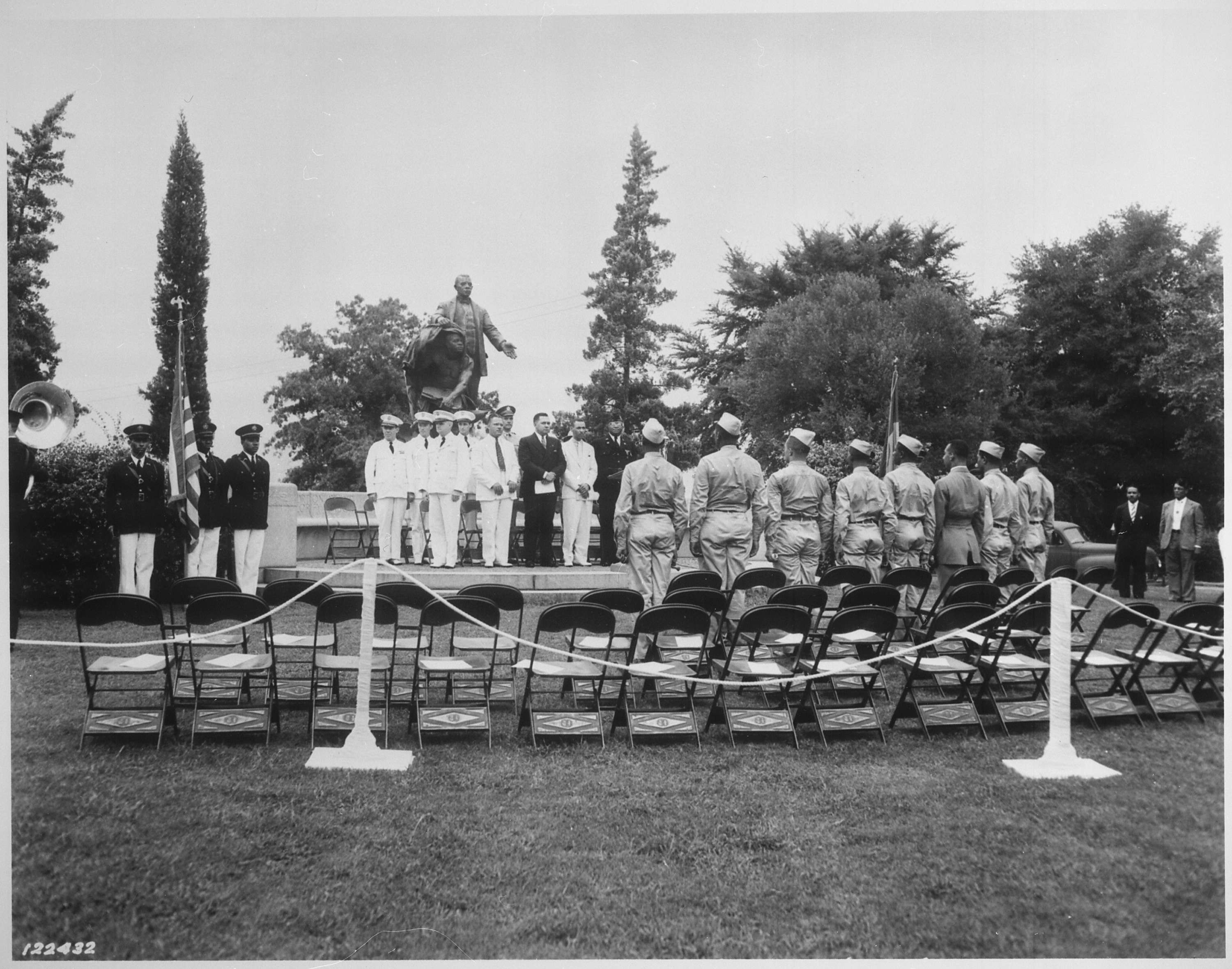Cadets at Tuskegee Institute
8/1941
Add to Favorites:
Add all page(s) of this document to activity:

This photograph shows Army Air Corps cadets in front of Booker T. Washington Monument on the grounds of the Tuskegee Institute during a welcome address.
During World War II, African Americans serving in the Armed Forces were segregated into all-Black units. There were also limits on the positions they could hold — for instance, they were not allowed to fly planes in combat at the beginning of the war.
On April 3, 1939, however, Congress passed legislation expanding the Army Air Corps (the precursor to today’s Air Force). Among the act’s provisions was the creation of training programs located at historically Black colleges to prepare African American servicemen for Air Corps service.
On January 16, 1941, the War Department announced they were creating the 99th Pursuit Squadron. (Fighter planes were then called "pursuit planes," hence the name Pursuit Squadron; during the war the term was replaced with "fighter squadron.") What made the 99th Pursuit Squadron different was that it was to be an all-Black flying unit trained at the Tuskegee Institute in Tuskegee, Alabama. War Department officials selected Tuskegee because it had an airfield and civilian pilot training program.
"Tuskegee Airmen" became the nickname for the World War II Army Air Forces units that were made up predominantly of African American pilots and maintenance crews.
From 1941 to 1946, nearly 1,000 African Americans completed training at the Tuskegee Institute as pilots, and many went on to serve with distinction during the war. Despite their service to the country, the U.S. military remained segregated until President Harry S. Truman issued Executive Order 9981 in 1948.
On March 29, 2007, the Tuskegee Airmen received the Congressional Gold Medal. During the ceremony, President George W. Bush acknowledged the men for their contribution to winning the war and saluted them for their service to the nation.
During World War II, African Americans serving in the Armed Forces were segregated into all-Black units. There were also limits on the positions they could hold — for instance, they were not allowed to fly planes in combat at the beginning of the war.
On April 3, 1939, however, Congress passed legislation expanding the Army Air Corps (the precursor to today’s Air Force). Among the act’s provisions was the creation of training programs located at historically Black colleges to prepare African American servicemen for Air Corps service.
On January 16, 1941, the War Department announced they were creating the 99th Pursuit Squadron. (Fighter planes were then called "pursuit planes," hence the name Pursuit Squadron; during the war the term was replaced with "fighter squadron.") What made the 99th Pursuit Squadron different was that it was to be an all-Black flying unit trained at the Tuskegee Institute in Tuskegee, Alabama. War Department officials selected Tuskegee because it had an airfield and civilian pilot training program.
"Tuskegee Airmen" became the nickname for the World War II Army Air Forces units that were made up predominantly of African American pilots and maintenance crews.
From 1941 to 1946, nearly 1,000 African Americans completed training at the Tuskegee Institute as pilots, and many went on to serve with distinction during the war. Despite their service to the country, the U.S. military remained segregated until President Harry S. Truman issued Executive Order 9981 in 1948.
On March 29, 2007, the Tuskegee Airmen received the Congressional Gold Medal. During the ceremony, President George W. Bush acknowledged the men for their contribution to winning the war and saluted them for their service to the nation.
This primary source comes from the Records of the Office of the Chief Signal Officer.
National Archives Identifier: 531132
Full Citation: Photograph 111-SC-122432; Address of welcome to [Army Air Corps] cadets in front of Booker T. Washington Monument on the grounds of Tuskegee Institute.; 8/1941; Photographs of American Military Activities, ca. 1918 - ca. 1981; Records of the Office of the Chief Signal Officer, Record Group 111; National Archives at College Park, College Park, MD. [Online Version, https://www.docsteach.org/documents/document/cadets-tuskegee-institute, April 26, 2024]Rights: Public Domain, Free of Known Copyright Restrictions. Learn more on our privacy and legal page.



